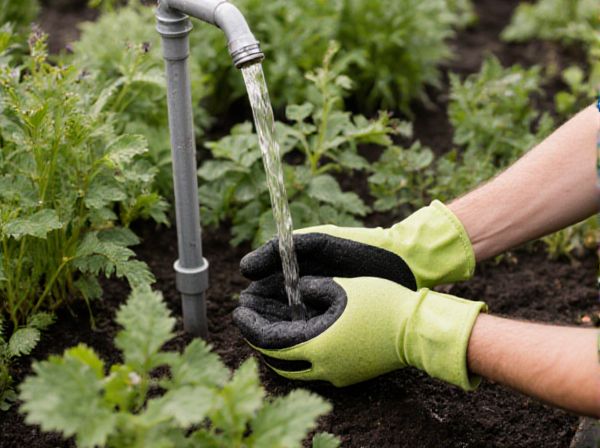
Greywater systems vs potable water irrigation Illustration
Greywater systems recycle household wastewater from sinks, showers, and laundry for irrigation, reducing potable water consumption and promoting sustainable water management in permaculture. These systems help conserve freshwater resources by safely redirecting non-toxic greywater to nourish plants, enhancing soil moisture without contaminating crops. In contrast, using potable water for irrigation increases water demand and costs, making greywater an eco-friendly alternative that supports resilient and water-efficient permaculture designs.
Table of Comparison
| Feature | Greywater Systems | Potable Water Irrigation |
|---|---|---|
| Source | Recycled household wastewater (excluding toilets) | Clean, treated drinking water |
| Water Quality | Contains low levels of contaminants and nutrients | High purity, regulated for human consumption |
| Environmental Impact | Reduces freshwater demand and wastewater discharge | Increases freshwater consumption and energy use |
| Cost | Lower operating costs after initial setup | Higher ongoing water bills |
| Health Risks | Potential pathogen risk; requires treatment and-safe use | Minimal risk; safe for all irrigation types |
| Suitability | Best for non-edible plants and soil irrigation | Suitable for all plants, including edible crops |
| Legal Regulations | Regulated; varies by region | Standard water use laws apply |
Understanding Greywater Systems: An Overview
Greywater systems reuse lightly contaminated household wastewater from sinks, showers, and laundry for irrigation, significantly reducing the demand for potable water in permaculture gardens. These systems lower water consumption by diverting greywater from septic or sewer systems while supporting plant growth with nutrient-rich water. Properly designed greywater systems prevent soil salinization and contamination, promoting sustainable water management in eco-friendly landscapes.
Potable Water Irrigation: Conventional Approach Explained
Potable water irrigation relies on treated drinking water sourced from municipal supplies or wells to nourish crops, often leading to high water consumption and increased pressure on freshwater resources. This conventional approach ensures pathogen-free irrigation but significantly raises operational costs and environmental impact due to energy-intensive treatment and distribution. Increasing water scarcity and sustainability concerns have prompted permaculture practitioners to seek alternative irrigation methods that reduce reliance on potable water.
Water Efficiency in Permaculture: Greywater vs Potable Water
Greywater systems in permaculture significantly enhance water efficiency by recycling household wastewater for irrigation, reducing reliance on potable water sources. These systems lower water consumption, minimize environmental impact, and support sustainable plant growth by directing nutrient-rich greywater to non-edible plants. Compared to potable water irrigation, greywater reuse improves overall resource management, promoting resilience in drought-prone permaculture landscapes.
Environmental Impact of Greywater and Potable Water Use
Greywater systems significantly reduce potable water consumption by recycling household wastewater for irrigation, lowering the demand on freshwater resources and decreasing the energy required for water treatment and distribution. Utilizing greywater reduces the strain on sewage systems and minimizes the discharge of contaminants into natural waterways, promoting healthier ecosystems. In contrast, potable water irrigation increases environmental footprint through high energy consumption, chemical treatments, and depletion of clean water supplies, making greywater reuse a more sustainable option in permaculture design.
Safety and Regulations for Greywater Irrigation
Greywater irrigation systems require strict adherence to safety guidelines and local regulations to prevent contamination and protect public health. Proper treatment, including filtration and disinfection, ensures greywater is safe for non-edible plant irrigation, minimizing risks of pathogen exposure. Regulatory frameworks vary by region but commonly mandate system design standards, usage restrictions, and routine maintenance to comply with environmental and health codes.
Installation and Maintenance: Greywater Systems vs Potable Water
Greywater systems require specialized installation including plumbing modifications and filters to safely reuse household wastewater for irrigation, reducing potable water consumption significantly. Maintenance involves regular monitoring of filters and pipes to prevent clogs and contamination, demanding moderate technical knowledge compared to standard potable water irrigation systems. Potable water irrigation installation is simpler with conventional piping, but ongoing maintenance focuses primarily on preventing leaks and ensuring system efficiency without the complexity of greywater treatment.
Plant Compatibility: Best Choices for Greywater Irrigation
Greywater irrigation is ideally suited for drought-tolerant, non-edible plants such as ornamental shrubs, native grasses, and fruit trees that can tolerate occasional exposure to soaps and detergents. Avoid using greywater for leafy vegetables, root crops, and herbs eaten raw due to potential contamination risks, emphasizing the need for plant compatibility to ensure safe and effective permaculture design. Selecting species with deep root systems enhances greywater absorption and reduces surface runoff, optimizing water reuse while maintaining soil health and plant vitality.
Cost Analysis: Greywater Systems Compared to Potable Water
Greywater irrigation systems significantly reduce water bills by reusing household wastewater for garden watering, cutting potable water usage by up to 50%. Initial installation costs of greywater systems vary between $500 and $3,000 depending on the complexity, often recouped within two to three years through lower water fees. In contrast, relying solely on potable water for irrigation incurs ongoing high expenses, with average annual garden watering costs ranging from $300 to $600 in urban areas.
Long-term Sustainability in Permaculture Gardens
Greywater systems enhance long-term sustainability in permaculture gardens by recycling household wastewater for irrigation, significantly reducing potable water consumption. These systems improve soil moisture retention and support plant health without depleting freshwater resources, aligning with permaculture principles of resource efficiency. Implementing greywater irrigation minimizes environmental impact while promoting resilient, self-sustaining garden ecosystems.
Real-life Case Studies: Success Stories and Lessons Learned
Real-life case studies highlight greywater systems' effectiveness in permaculture by showcasing significant reductions in potable water usage for irrigation, often saving up to 50-70% in household water consumption. Successful implementations illustrate how greywater reuse enhances soil moisture retention and plant growth without compromising water quality, while lessons emphasize the importance of proper filtration and system design to prevent contamination and maintain ecosystem health. These practical examples demonstrate permaculture's potential for sustainable water management, promoting resilience in drought-prone and water-scarce regions.
Greywater systems vs potable water irrigation Infographic

 gardendif.com
gardendif.com